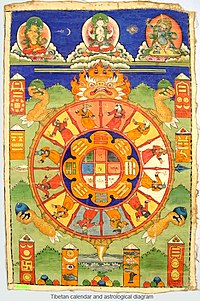Tibetan calendar

The Tibetan calendar is a way to keep track of time that is used in Tibet and other parts of Asia. It is based on a combination of the Chinese calendar and Tibetan Buddhist teachings. Like the Chinese calendar, the Tibetan calendar divides time up into years, months, days, and hours. It follows a 12-year cycle with each year having 12 or 13 months. The year starts in February and lasts until January of the following year. Each month has 29 or 30 days and each day is divided into 24 parts, with each part lasting for 1 hour. In the Tibetan calendar, major festivals and important Buddhist days are marked.
Related topics others have asked about:
